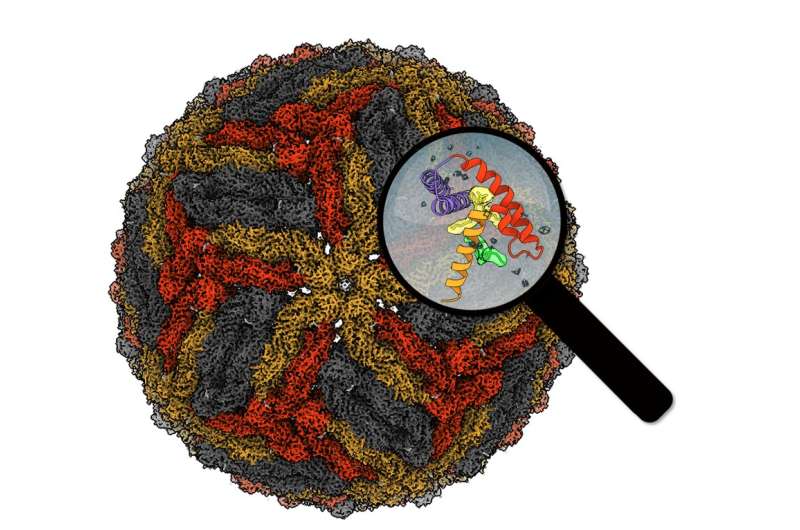Chimeric viruses unearth hidden gems in dengue virus structure

In a recent study, Australian scientists used an original approach to resolve the 3D structure of flaviviruses with an unprecedented level of detail, identifying small molecules known as 'pocket factors' as new therapeutic targets.
Flaviviruses infect humans by mosquito or tick bite, with symptoms ranging from fever and myalgia to life-threatening neurological and congenital conditions. Flaviviruses such as dengue, yellow fever and Zika threaten almost a third of the world's population, and new flaviviruses emerge regularly from animal reservoirs with the potential to cause epidemics.
There are currently no approved antiviral drugs for flavivirus infection and most flaviviruses lack a vaccine. Structures of infectious particles are essential to map the vulnerabilities in the viral outer surface to design better therapeutics. However, structure determination of highly pathogenic flaviviruses is only possible in very few locations across the world where microscopes are contained in high biosecurity environments.
In the study, published in Nature Communications, a team led by Associate Professor Fasséli Coulibaly from Monash University and Associate Professor Daniel Watterson from the University of Queensland, have generated three new flavivirus structures using an approach that does not require the same level of containment.
This approach takes advantage of a unique flavivirus first isolated from mosquitoes in the Binjari area. The virus has no known vertebrate—specifically human—host, making it easy to manipulate without risk of human infection. The researchers used the Binjari virus as a platform to produce benign chimeric viruses with the outer shell of medically-relevant viruses.
The team used the Ramaciotti Centre for Cryo-Electron Microscopy at Monash University to determine structures of the chimeric particles. They found that these viruses mimic the infectious particles of several pathogenic flaviviruses in the finest details. This provides a universal path to the safe and rapid structure determination for existing and emerging flaviviruses.
"Because the structural proteins are derived from the human-infecting virus, the particles look like the pathogenic virus. It means that we can determine the structure of these proteins in a native context and that these particles can be used for vaccinal and diagnostic purposes," said Associate Professor Watterson.
Associate Professor Coulibaly said the level of detail of these models was unprecedented with the ability to visualize water molecules and tiny pocket factors nestled within the infectious particles.
"Due to the impressive resolution of our structures we were able to build accurate models for these viruses. We saw how the pocket factors bind to conserved parts found in all pathogenic flaviviruses. Their location suggests they could be the final linchpin to ensure the infectious particle is securely fastened before its release from the cell," he said.
More information: Hardy, J.M., Newton, N.D., Modhiran, N. et al. A unified route for flavivirus structures uncovers essential pocket factors conserved across pathogenic viruses. Nat Commun 12, 3266 (2021). doi.org/10.1038/s41467-021-22773-1
Journal information: Nature Communications
Provided by Monash University





















